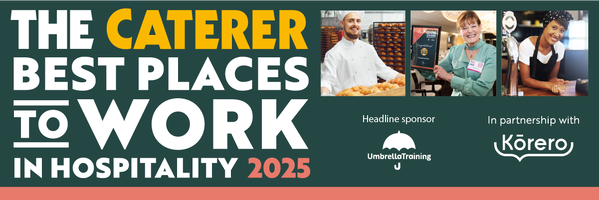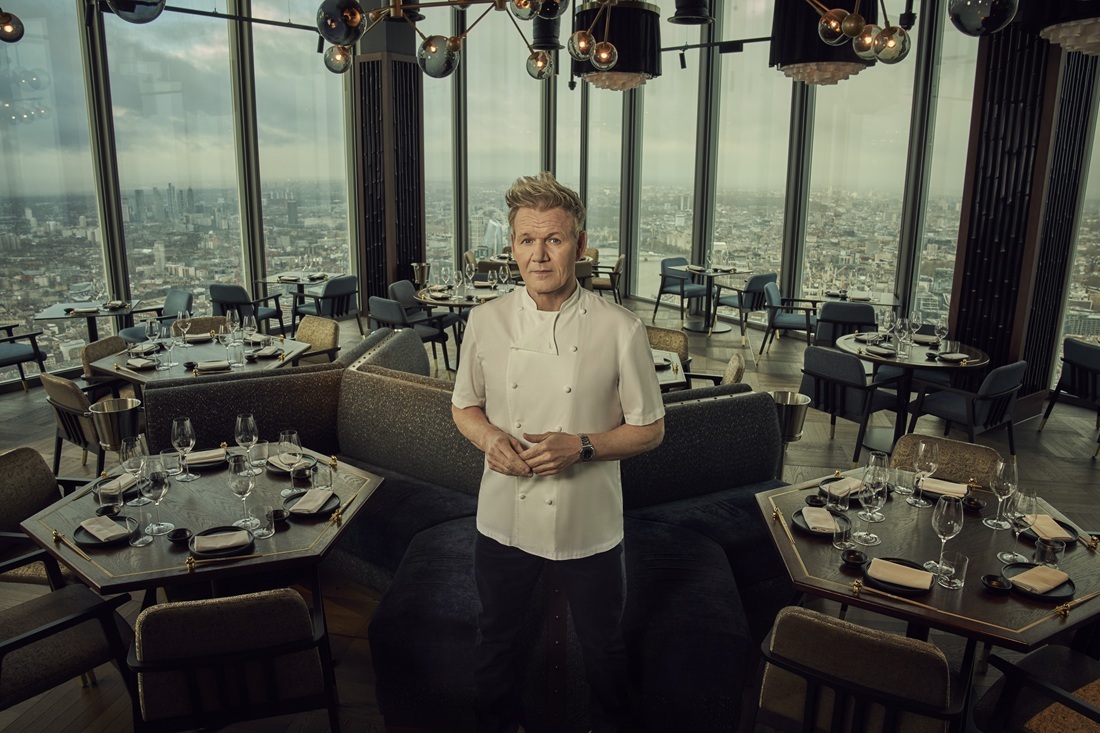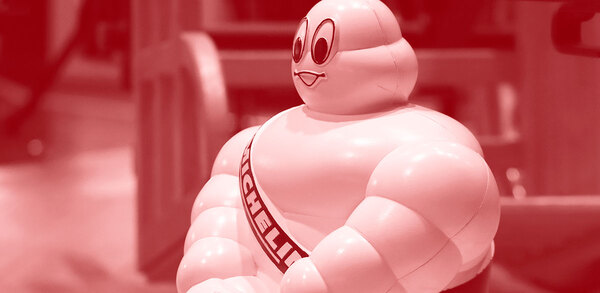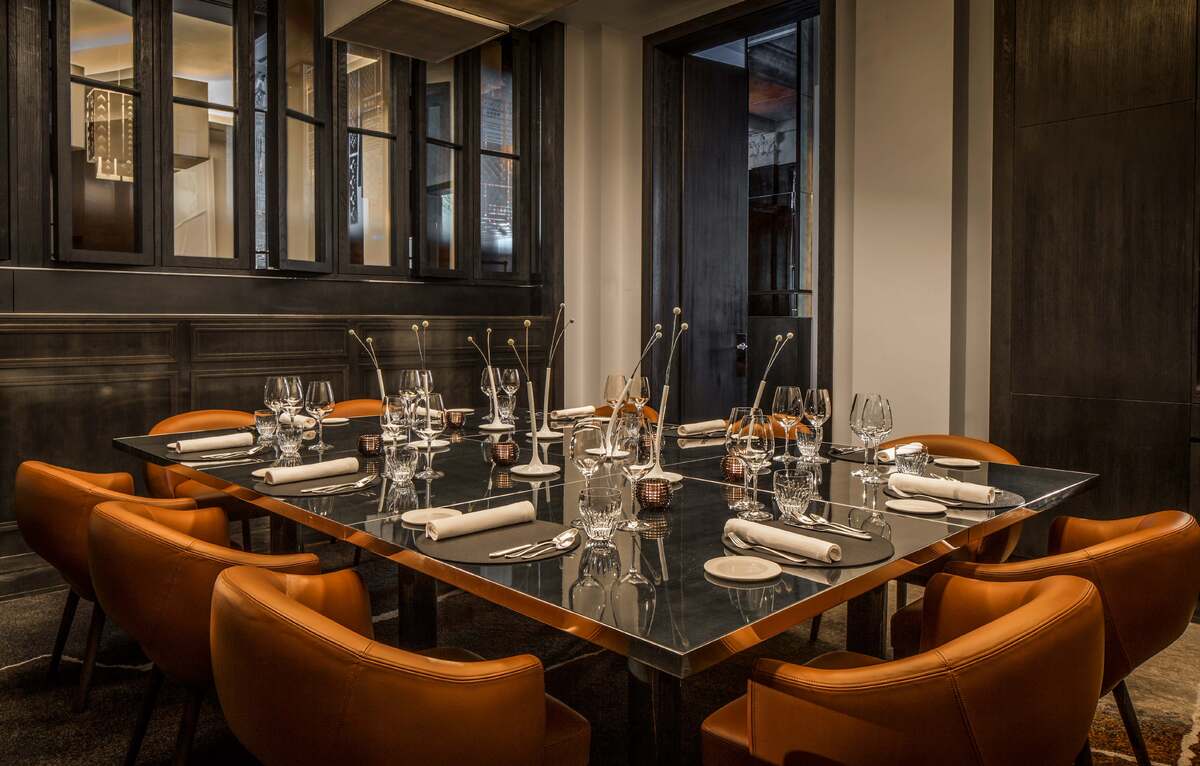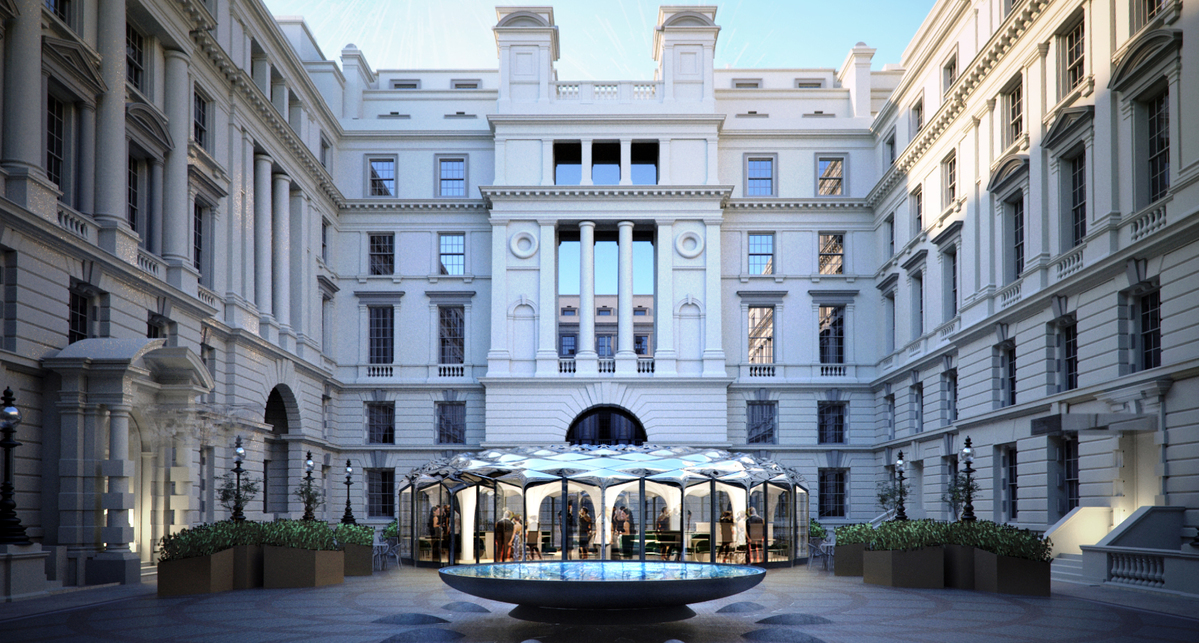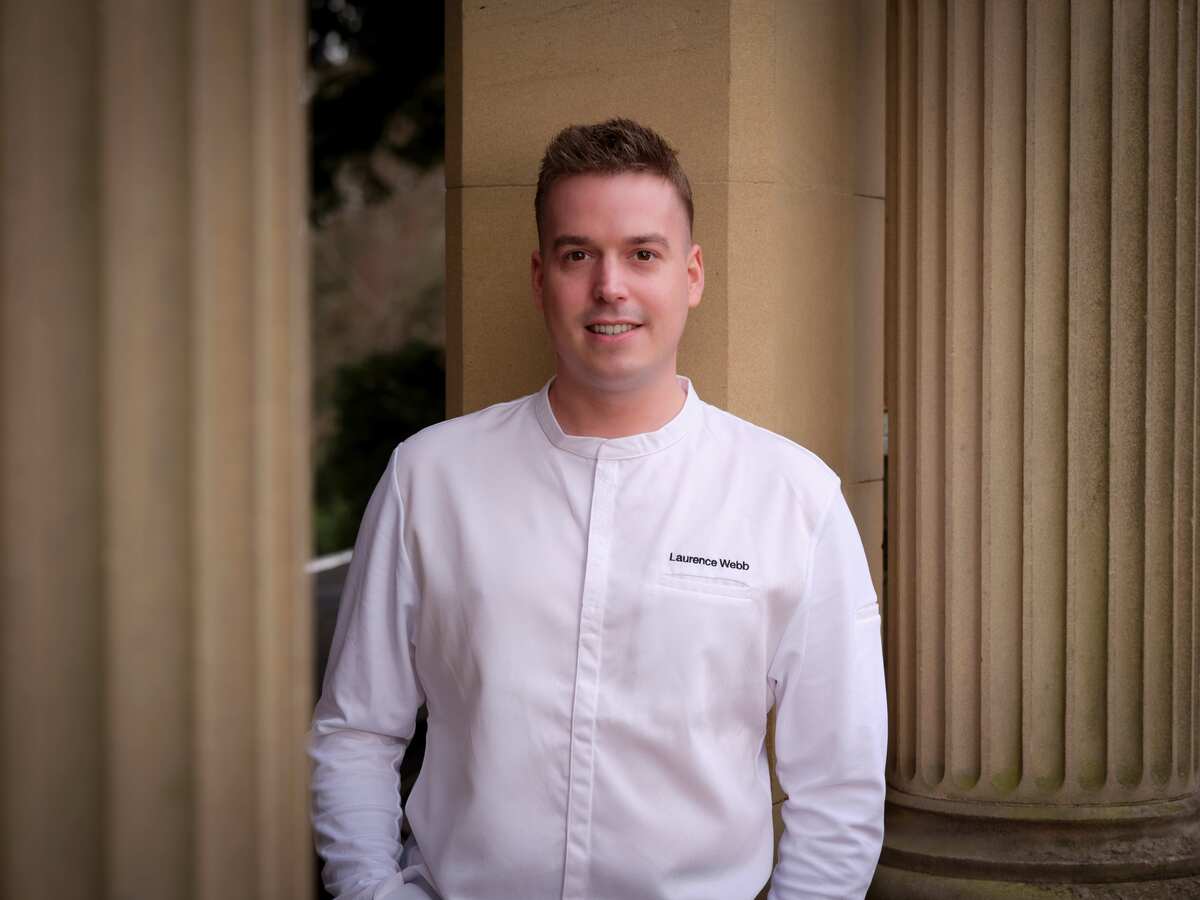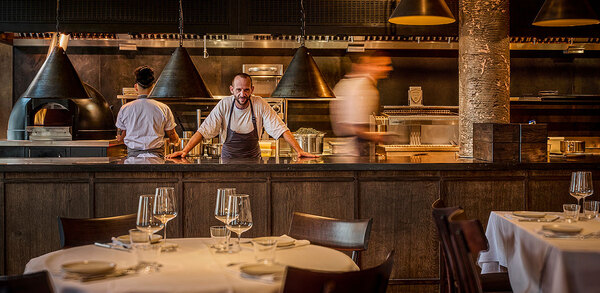Le Gavroche at forty
It's four decades since London got a taste of the Roux brothers' fine French cooking at Le Gavroche, and the restaurant is still very much a family business. Margaret Clancy looks at how they've moved with the times
The entrance to Le Gavroche, in London's Upper Brook Street, is unassuming: a plain door with a little glass canopy overhead to protect visitors from the elements as they enter. Inside, there's an eclectic collection of modern art and a few family portraits and prints, but there's no great design theme. The plush velvet of the chairs and banquettes and the heavily skirted tables are luxuriously comfortable, but it's the antithesis of the chic modernity that we've come to expect from a busy two-Michelin-starred establishment. But then Le Gavroche has always been an exception to the rule.
This seminal restaurant was opened in Lower Sloane Street in London in the spring of 1967 by two young, keen and exceptionally talented Frenchmen, Albert and Michel Roux. The older of the two, Albert (now aged 72), had been working in England as a private chef to the Cazalet family for eight years and generously puts all the early success of the restaurant at their feet.
"First, they helped me with money," he says. "It cost me £1,500 to set up Le Gavroche and we had only £500. The Cazalets gave me £500 as a leaving present and they raised the other £500 that we needed from their friends."
Customers
Just as importantly, the Cazalets helped with customers. Mrs Cazalet ran the family house "like a six-star hotel", Albert says, with notes on guests' likes and dislikes, menus and interests. The hot young chef in the kitchen learnt how to please not only his employers but also his employers' friends, some from the highest echelons of British society. And when the restaurant was finally ready to open, Mrs Cazalet invited her circle of friends to the mother of all restaurant launch parties.
"It was a 60-seat restaurant but we had 450 guests on the night," Albert recalls. "There were people partying in the kitchen and on the stairs. I hate to think what Health & Safety would have to say about it now."
But the launch worked. The restaurant was fully booked on the first day of trading 40 years ago and it still is today. The only time when the numbers went down was in the late 1970s when the IRA was targeting London.
"It was a real problem. Our restaurant was filled with grand people and politicians so it could have been a prime target. We ended up putting a metal grille over the windows so that a passer-by could not throw in a hand grenade during the dinner service."
Then, as now, the restaurant attracted huge amounts of publicity, and of course became one of the most sought-after places to work. Albert and Michel took the idea of training seriously, and although the regime was one of the toughest, those that made it through had - and still have - a good chance of making it to the top of the business. Indeed, most of the country's biggest names in catering have spent formative years in the kitchen at Le Gavroche (see page 26). In 1985, Albert and Michel went a step further and formed the Roux Scholarship, encouraging young chefs from all over the country to compete for a placement in their restaurant (or any other three-Michelin-star establishment), an award that is still one of the biggest and most sought-after prizes available to young chefs (www.rouxscholarship.co.uk).
The same standard, of course, has always been expected front of house, where lunch now sees 60 covers at £60 a head and dinner 80 covers at £130 a head. General manager and director Silvano Giraldin, who joined as maitre d' 37 years ago and was made manager in 1974, admits that the regime is hard and his high standards take no prisoners, "but my boys and girls thank me in the end," he says.
Giraldin has a team of about 25, a ratio of one waiter to three customers, but he makes no apology for this: "We've always had a big staff front of house, but it would be impossible to deliver this level of service without it."
He sees his job as keeping the customers happy, as well as being the eyes of the kitchen. "Albert used to say that we had to keep up the reputation of the restaurant, but that we were only as good as the service we had just done - and the one in front of us had to be the same standard. After all, if you please a customer, he may come back again and again, but if you get it wrong once, you've lost the customer for ever."
And if that sometimes meant confronting Albert with a dish that was not perfect, Giraldin would do just that. "There were sometimes huge sparks in the kitchen, but if I saw something not quite right, I would always say so - moving quickly afterwards to the dining room to escape the wrath."
Giraldin admits that things are much less explosive with Albert's son, Michel Jnr, who joined in 1991 - "he has a different temperament" - but he still refuses to send out an occasional dish that he thinks is below standard.
The logistical problems of running a high-class restaurant 40 years ago are almost unimaginable today. England had seen the end of rationing only relatively recently (in 1954) and the idea of specialist growers or top-end ingredients on our own shores was unheard of.
"There are some things that England does really well, then as now," Albert says. "We could get beautiful lamb and beef and I persuaded fishermen to send me the whole of their catch, whatever they'd caught, so that I could serve it really fresh in the restaurant."
But other luxury ingredients were much harder to find and Albert and his then wife, Monique, took the matter into their own hands.
"Monique used to drive to Paris every week with a car full of the finest beef and lamb we could get to swap for good chicken, foie gras, mushrooms and charcuterie," he admits.
On the way back she would smile innocently to the customs officials and most of the time she was allowed through. Occasionally she was stopped and would have to take the whole car-full back to France, where she would drive round to the next port and make a different crossing over to England.
"It was illegal and risky, but the results were worth it and she never failed to make the crossing," Albert says.
He is at a loss to know what the then minister of Agriculture, Fisheries & Foods thought he was doing when he tucked into these smuggled delicacies at lunchtime. Of course, once EEC trade regulations relaxed, Roux took the opportunity to establish a proper import and export business, and brought food in from the Paris market, Rungis, every week, eventually supplying most of the top establishments in London with their fine salads and produce, and though there was a certain amount of rule-flouting - "the red tape was unbelievable" - Le Gavroche's smuggling operations came to an end.
Lighter touch
Michel Jnr's hand at the pass has changed more than the extent of the fireworks in the kitchen. His is a younger, lighter touch. Giraldin comments: "His cooking is more modern and fresh. Watching him steer the kitchen from his father's cooking to follow his own path has been very impressive."
It is true that Le Gavroche no longer has three Michelin stars, but a placement in the kitchen or front of house here is as desirable for the next generation of chefs and maitre d's as it ever was, and Michel Jnr truly does not regret the star's loss.
"Certainly, I would love three stars. I believe in the system and the recognition would be wonderful. But I am not cooking that style of food. There are dishes that are worthy of it, but my style really doesn't suit that status. Besides, we have changed the feel of the restaurant over the past 16 years since I took over. People come here to laugh, to enjoy themselves and to have great food. We are not a temple and there are no hushed voices. With a third star that would change again and I don't want it to."
And though the menu is a much leaner, fitter affair under the younger Roux, there are Gavroche classics that will never fade. "Some people who came here when we first opened still come, their children come and their grandchildren come," explains Michel Jnr. "We tried once to remove the Soufflé Suissesse (cheese soufflé baked on double cream) but there was uproar so we quickly brought it back. We've lightened the recipe for Le Caneton Gavroche [whole poached duck in a light consommé served with three sauces for two] but it's still there and there'll always be an omelette Rothschild.'
So, what of the next chapter in the history of this grand institution? Giraldin will start to take a step back next year after 34 years in charge front of house but he has been training his replacement for years and he thinks the changeover will be almost unnoticeable.
"I will still be here, but I shall start to do less than 10 shifts a week. I am looking forward to taking it a bit easier," he says.
As for Michel Jnr, he has many years in the kitchen before him and his 16-year-old daughter, Emily, has shown a keen interest in the industry. "She's worked in the kitchen here a little bit and she is going to try to work in the room in the summer," he says.
Does he hope that she'll follow his footsteps? "Let's wait and see," he answers pragmatically.
Win a stage at Le Gavroche
Michel Roux Jnr is offering one lucky chef or trainee chef the chance to spend a day working with his brigade in the kitchens of Le Gavroche.
To enter the competition, simply submit your CV with a 20-word sentence explaining why you deserve to win this opportunity. Post your entry to Ian Haworth at Redleaf Communications, 9-13 St Andrew Street, London EC4A 3AF
Candidates must be over 18.
Staples in the larder
1967 Cheese, foie gras, butter, cream, good stocks, fine herbs and spices, great meat and fish. Classic staples of the time such as smoked salmon, caviar and French fries were banned.
2007 Olive oil, walnut and hazelnut oil, wild mushrooms, herbs and spices. Great fish and meat. Cheese, both English and French. Salads and herbs.
Specialities of the house…
| 1967 | 2007 | |
|---|---|---|
| Soufflé Suissesse | 19s (2 pers) | £19.90 (1 pers) |
| Caneton Gavroche | 70s (2 pers) | £62.60 (2 pers) |
| Omelette Rothschild | 30s (2 pers) | £20.80 (1 pers) |
1967 Opened in Lower Sloane Street by brothers Albert and Michel Roux.
1972 The brothers also open the Waterside Inn at Bray, Berkshire.
1974 Silvano Giraldin becomes general manager at Le Gavroche. The Red Michelin Guide reaches London and Le Gavroche is awarded its first Michelin star.
1977 Wins its second Michelin star.
1981 Moves to new premises in Upper Brook Street.
1982 Awarded three Michelin stars.
1986 Le Gavroche and the Waterside split. Le Gavroche is solely under the hands of Albert Roux.
1991 Albert's son, Michel Roux Jnr, joins the family business.
1992 Michel Roux Jnr takes control and starts a gentle change of direction.
1993 Michelin demotes Le Gavroche to two stars.
2007 Le Gavroche as successful as ever, with a table in the restaurant or a placement in the kitchen or room still enormously sought after. It serves 60 covers at £60 a head for lunch and 80 at £130 a head for dinner.
Le Gavroche family tree
Pierre Koffmann
Former proprietor, La Tante Claire, London, now chef-consultant
1970-1972 Started as a commis and after two months was promoted to sous chef
"Everything at Le Gavroche was done to please the customer. Standards were always so high, even when chopping onions. Everything sent had to be perfect and consistent. It was a major influence on me - particularly the quality of the food and service. The front-of-house service was fantastic."
Christian Delteil
Former managing director, Bank Restaurant Group, now chef-consultant
1975-76 Started as demi chef de partie, then chef de partie, then sous chef
"Le Gavroche was the first restaurant to do bourgeois cooking, with great intensity shown in every dish. It has always maintained the standard that it was set up to achieve. Young Michel has taken it to a different level - and it should be three stars now. It is very impressive to see it passed on to the younger generation and still retain the same consistency. I remember the water fights we used to have after service and for some reason, on one occasion we all went naked - except for our aprons."
Michael Hutchings
Personal chef-caterer, California
1978-81 Initially chef de partie and later the first American to hold the position of sous chef
"Working at Le Gavroche was a key time in my career. Albert arranged for me to do stages all over Europe and at the other Roux outposts in London and when I returned to the USA I opened Michael's Waterside Inn in Santa Barbara with the Roux brothers' backing. Albert was a taskmaster who made you want to excel. On one occasion I was asked to do a special dinner and spent four hours preparing a dish with woodcock, lots of truffles and a sauce finished with foie gras. We sold only one and the rest was served for the staff meal the next day. I wasn't happy that the dish didn't sell Albert's only concern was that I was happy with the dish - it spoke of a dedication to perfection."
Paul Grout
Co-owner, Butcher & Grill, London
1978-82 Started as an apprentice
"There was never any compromise on standards, quality and effort. Michel has picked up the ethos of his dad and uncle and evolved it."
Stephen Doherty
Executive chef, First Floor Café, Lakeland, Windermere, Cumbria
1978-80 and 1985-88 First stint: commis, progressing to chef de partie second stint: sous chef progressing, after two years, to head chef
"The attention to detail, sheer professionalism and level of intensity of Le Gavroche has filtered through to everyone who has worked there. I recently returned to the kitchen, and all these things are still there, exactly as before - although Michel has developed his own style and made it relevant to the restaurants of today."
Rowley Leigh
Chef-proprietor, Le Café des Anglais, Bayswater, London (due to open in September)
1979-81 Started as a commis and progressed to chef de partie
"Going to Le Gavroche was, for me, a huge step into a world I hadn't experienced before. I was thrown into it head first, but everyone was extremely kind and helpful in getting me to a useful place. The restaurant has remained a fixed point and great benchmark for what is good. It has never been influenced by fashion. The fact that it is run by an incredibly strong family is key."
Robert Mabey
Chef-proprietor, Regatta Restaurant, Aldeburgh, Suffolk
1981-82 Chef de partie
"When I was at Le Gavroche the competition was not so much from other restaurants in England, but from the big boys in France. Albert would often come back with ideas from Paris or Troisgros to ensure that we kept up with the genre of three-Michelin-starred restaurants. He fostered a tremendous understanding of quality in all of us and a belief that we were in charge of our own destinies - hence the reason so many of us have gone on to run our own businesses. The energy and banter were infectious, but the stress was enormous. I used to suffer headaches every weekend and was told by my doctor that it was due to the adrenalin drop after five days of non-stop work."
Roger Narbett
Chef-proprietor, the Chequers, Cutnall Green, Worcestershire, and the Bell & Cross, Clent, Worcestershire, and chef to the England football team
1983 Started as first commis on hors d'oeuvres and progressed to chef de partie on fish section
"I arrived at Le Gavroche from the Waterside Inn. I've always felt that both Roux brothers have been there to nurture me as part of their family. Albert helped me move on to work at Troisgros in France and so fulfilled one of my long-held ambitions. When I arrived at Troisgros I was told to slow down as I'd been used to working at 100 miles per hour at Le Gavroche. It was physically tough, but an experience that I would not have missed."
Paul Rankin
Chef-proprietor, Rankin Group (incorporating four different brands of restaurants in Northern Ireland
1984-86 Began on the dish wash, eventually progressing to chef de partie.
"Le Gavroche gave me the base on which I've built my career. Albert was a total inspiration. Whenever you go back you are made to feel amazing and special - a part of the family. It is a restaurant that offers genuine hospitality and Silvano is a huge part of what has made Le Gavroche successful.
Mark Raffan
Chef-proprietor, Gravetye Manor, East Grinstead, West Sussex
1985-86 Worked as demi chef de partie on salad, cold starters and sauce sections
"Albert was such a huge icon - he's like a father to me. It was a fantastic place to work - there was nothing else to touch the place at the time. It was mind-blowing. I picked up three years' knowledge in my one year there. Working 16- or 17-hour days was incredibly tough, but fair. Without a doubt I wouldn't be the owner of Gravetye now if I hadn't worked there."
John McManus
Executive chef and operations manager, Queenwood Golf Club, Ottershaw, Surrey
1986-87 Sous chef
"I ate at Le Gavroche with my girlfriend, Fiona (now my wife), when I was a young chef straight out of Accrington College in Lancashire. We were both just 18 and were completely bowled over by the food and service. We were made to feel so special and I vowed then that one day I would go back to work there, which I eventually did eight years later. The experience set a benchmark on discipline, attention to detail and consistency which I have followed for the rest of my career."
Gordon Ramsay
Chef-proprietor, Gordon Ramsay Holdings
1988-1990
"The spirit of Escoffier is alive and kicking at Le Gavroche and has been since the 1960s. When I joined the team in 1988 it was the place every chef wanted to be. The energy needed to work there was immense, but the results were phenomenal."
Stuart Oetzmann
Proprietor, Metfield akery, Dereham, Norfolk
1989 Pastry commis
"Le Gavroche is an iconic restaurant. It was one of the first restaurants to judge itself on quality and swept away all the austerity that had followed war-time rationing. The quality of staff that it has turned out has been phenomenal - all highly driven and determined chefs with a fantastic work ethic. The Roux name stays with us all and has been important in opening doors for many of us, all these years later."
Marcus Wareing
Chef-patron, Pétrus, London
1989-9
"Le Gavroche was the pioneer of French cooking in England. Before then French cooking was virtually non-existent. Almost every great British chef has a connection with the restaurant."
Mark Prescott
Chef-proprietor, Mulberry Tree, Wrightington, Lancashire
1989-1998 Started as chef de partie, became sous chef under Stephen Doherty, and then head chef in 1991
"Le Gavroche is an institution. The chefs who worked there did so because they were passionate about cooking, not because they wanted to become celebrities. It was very competitive in the kitchen - a bit like a boot camp. The ones who survived and came through it were extremely competent chefs. There was a lot of talent working together and everyone wanted to be top dog. It was an amazing atmosphere to be working in. We felt we were the best in London, if not the world. I didn't regard it as just a job - if I did, I wouldn't have lasted more than two days."
Stephen Terry
Chef-proprietor, the Hardwick, Abergavenny, Gwent
1990-91 Worked in the pastry, larder, veg and fish sections
"Le Gavroche has legendary status. If it were a stone, it would be the one used to build the foundations. It is the strongest stone. Any young chef who can afford to live in London and who is really serious about learning to cook well should go and work at Le Gavroche. The kitchen was very disciplined and if you got caught mucking around, you got a serious telling off. We were doing a big clean down one Friday afternoon and some of the guys were flicking wet cloths. Max flicked Gordon on the arse - the force was so great that it split his trousers. Everyone thought it was very funny. That evening, in the middle of service, Gordon cracked an egg on to Max's head and then replaced his hat. Max couldn't do anything about it and just carried on working for the rest of the service."
Max Gnoyke
Managing director, Heathcotes Restaurants
1990-91 Started on the fish section
"I was on the fish with Marcus as my commis Gordon was on the sauce with Steve Terry as his commis. Le Gavroche was a bastion of excellence - all down to Albert and Michel in the kitchen and Silvano in the restaurant. We used to run around like lunatics for 20 hours. It was sheer bloody hardy work - we did three days' work in one day. There was no slack from what seemed like 5am on Monday morning to 2am on Saturday morning. Nothing short of perfection was good enough. It has now become de rigueur to use the best producers and understand where the product came from - Le Gavroche was doing that back then, but didn't shout about it."
Steve Williams
Executive chef, Stanley House, Mellor, Lancashire
1990-91 Premier commis
"The talent all around me was amazing - imagine working alongside Gordon Ramsay as a commis. More than anything, working at Le Gavroche instilled in me a self-discipline to be smart, be proud and have total respect for the trade. I felt privileged and honoured to be there, but it was very tough. Often I'd ring my mum at night and cry. It's certainly the hardest thing I've ever done, but also the best."
Thierry Busset
Pastry chef, CinCin, Vancouver, Canada
1991 Chef de partie, pastry section
"Working at Le Gavroche will open any restaurant door anywhere for you in the world - it certainly has been enormously helpful for me during the seven years I've been in Canada. What impressed me most was Albert's and Michel's keenness to teach the young chefs and always ensure absolute consistency throughout the kitchen."
Brian Maule
Chef-proprietor, Brian Maule at Chardon d'Or, Glasgow
1992-2001 Worked his way up from chef de partie to head chef
"The discipline and organisational skills that they instilled were fantastic, together with the quality and detail of food on the plate and a respect for ingredients. It had a major impact upon my career. I still have a very good relationship with Michel and Albert - its more than just a relationship with old bosses, it's a close friendship."
Darren Simpson
Chef-proprietor, La Sala restaurant, Sydney, Australia, and one of Australia's premier television chefs
1992-93 Started as a commis and progressed to chef de partie in the pastry section
"Le Gavroche gave me everything as a chef. I'd been previously working at Roscoff with Paul Rankin and he urged me to go to Le Gavroche because of his fantastic experience and I'm glad I took his advice. Looking back at that time the kitchen was like a crèche for the very best chefs."
Martin Wishart
Chef-proprietor, Restaurant Martin Wishart, Leith, Edinburgh
1993-94 Commis chef
"Working at Le Gavroche taught me how to work in a clean, professional, organised way and put me on the right path for the future. I worked with so many fantastic products and gained so much knowledge. The fact that so many great chefs have come out of the kitchen is testament to the brilliance of the kitchen."
Marco Pierre White
Restaurateur
"I was inspired by the honesty, the attention to detail, the controlled extravagance that I found at Gavroche. Albert taught me the proper use of extravagance, and he was one of the few people who could control me. He has been like a father figure to me over the years. He had time for me and tried to understand me and I thank him for that." (An extract from White Heat)
Andrew Fairlie
Gleneagles
The first Roux Scholar - 1985
"It was not just a prize on the day, it was a great responsibility and the start of an institution. The wealth of knowledge and the support that it gave me access to was extraordinary. I am still, 23 years later, in touch with the brothers and they are still supportive. We've recently set up a network of winners so that we can all be of help to each other."



